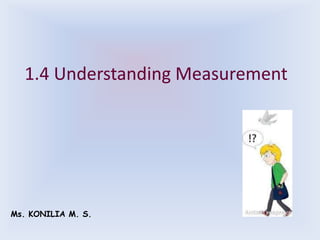
1.4 measurement
- 1. 1.4 Understanding Measurement Ms. KONILIA M. S.
- 2. Error in Measurement the difference between the actual value of a quantity and the value obtained in measurement. may occur due to incorrect skill of handling the instruments or when reading the data. Error can be reduce if error are known and how it happen
- 3. 2 Types of Error •Systematic Error •Random Error
- 4. Systematic errors tend to shift all measurements in a systematic way so their mean value is displaced. can be compensated if the errors are known. Examples of systematic errors 1. Zero error o cause by an incorrect position of the zero point of measuring instrument. o consistently present in every reading of a measurement. o can be positive or negative
- 6. 2. an incorrect calibration of the measuring instrument. 3. consistently improper use of equipment. Systematic error can be reduced by 1. Conducting the experiment with care. 2. Repeating the experiment by using different instruments.
- 7. Random errors arise from unknown and unpredictable variations in condition. It vary from one measurement to the next. caused by factors that are beyond the control of the observers. Factor of random error can cause by 1. personal errors such as human limitations of sight and touch. 2. lack of sensitivity of the instrument: the instrument fail to respond to the small change. 3. natural errors such as changes in temperature or wind, while the experiment is in progress. 4. wrong technique of measurement (parallax error)
- 8. Parallax error • error in reading an instrument due to the eye of the observer and pointer are not in a line perpendicular to the plane of the scale.
- 9. Random error can be reduced by 1. taking repeat readings. 2. find the average value of the reading.
- 10. Sensitivity of measuring instrument • ability to detect small changes in the quantity that is being measured. • a sensitive instrument can quickly detect a small change in measurement. • Measuring instruments that have smaller scale parts are more sensitive. • Sensitive instruments need not necessarily be accurate.
- 11. Try this!.... • Which instrument is more sensitive, a vernier calliper or micrometer screw gauge? • Why measurement of large quantities (kg or km) does not required sensitive instrument?
- 12. Precision and Accuracy Precision • the ability of an instrument in measuring a quantity in a consistent manner with only a small relative deviation between readings. • The precision of a reading can be indicated by its relative deviation. • Can be improve by: Eliminating parallax error during measurement Using instrument which is not defective.
- 13. Accuracy • the approximation of the measurement to the actual value. • The measurement is more accurate if its number of significant figures increases. • The accuracy of a measurement can be increased by 1. repeat readings to calculate the mean value of the reading. 2. avoiding the end errors or zero errors. 3. taking into account the zero and parallax errors. 4. using more sensitive equipment such as a vernier caliper to replace a ruler.
